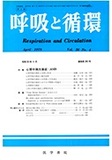Japanese
English
- 有料閲覧
- Abstract 文献概要
- 1ページ目 Look Inside
近年心エコー図(Echocardiography以下UCGと略す)による心臓診断学の進歩はめざましく,たんに疾患の診断のみならずその重症度や術前後の評価など,量的な診断も必要となってきた。僧帽弁は最も記録され易い位置にあり,僧帽弁狭窄症に対する研究は1950年代の半ばから始まり,数多くの報告がなされてきた。
リュウマチ性僧帽弁狭窄症の診断基準のひとつとして,僧帽弁前尖の拡張期後退速度(Diastolic Descent Rate:以下DDRと略す)の低下とともに,僧帽弁後尖の拡張期前方運動すなわち拡張期に前尖と後尖は平行に前方へ運動することがあげられてきた1)。肥大性心筋症2),大動脈弁狭窄症3),虚血性心疾患3),原発性肺高血圧症4,5)など僧帽弁前尖のDDR低下をきたす疾患では,僧帽弁狭窄症との鑑別が問題になるが,これらの疾患では後尖は拡張期において前尖とほぼ対称的な後方運動を示すため,特に"false MS"とよばれている1)。一方臨床的に明らかな僧帽弁狭窄症でも,僧帽弁後尖が拡張期後方運動を示す症例が数少いが報告されはじめている6)。
Echocardiograms before and after operation were analyzed in 56 patients with pure mitral stenosis confirmed at surgery (39 open mitral commissurotomy and 17 mitral valve replacement).
The patients were devided into three groups: Group A, 12 patients who showed the diastolic posterior motion of the posterior mitral leaflet after operation ; Group B, 27 patients who showed the diastolic anterior motion of the leaflet after operation; Group C, 17 patients who had mitral valve replacement.

Copyright © 1978, Igaku-Shoin Ltd. All rights reserved.


